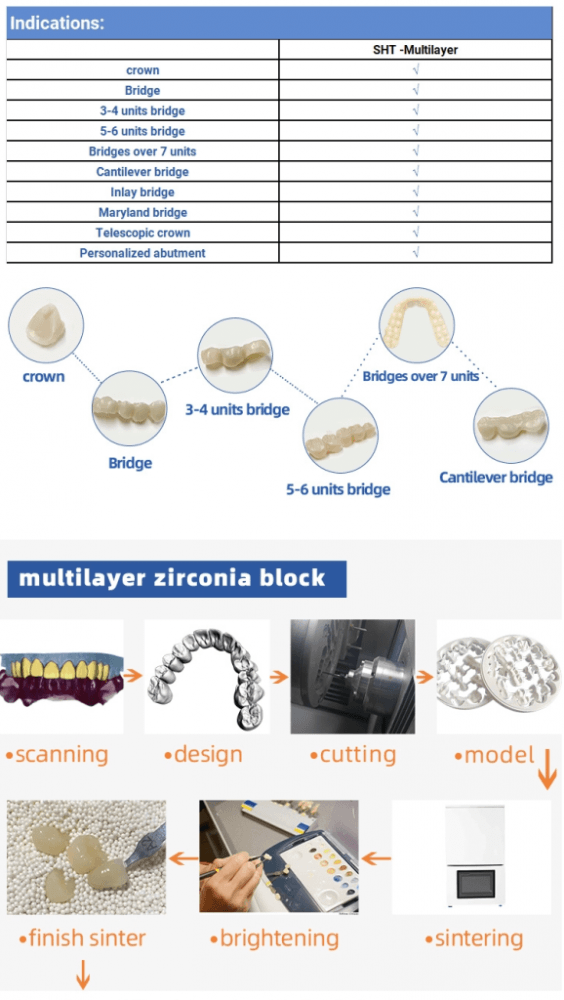Why does the dentist favour zirconia teeth
1. What is zirconia ceramic teeth
All-ceramic zirconia teeth are made of high-temperature,wear-resistant, and corrosion-resistant inorganic non-metallic materials; they are teeth made of a mineral that exists in nature with oblique zircon. Zirconium all-ceramic teeth are all made with computer CAD-CAM technology, that is, laser scanning,computer-aided design, and three-dimensional numerical control professional machine tools to process suitable crowns or bridges zirconia teeth. The zirconium all-ceramic tooth produced by this method has extremely high adhesion.

It is recognized as the first choice for “beauty teeth” by beauty lovers all over the world. After finishing the zirconium all-ceramic teeth, eat some softer foods, and eat normal foods after getting used to it.
The light transmittance, color, and shape of the metal inner crown are quite different from those of natural teeth, and it will also produce a blue-gray effect under light. At the same time, the metal porcelain teeth are unstable under the action of bacteria in the acid-base environment of the liquid oral cavity. The metal has a certain interference when the patient performs CT MRI. Therefore, the dental medical community has been working hard to change this state. The current international dental community favors the latest porcelain tooth with no metal inner crown-all ceramic zirconia teeth. That is the reason why the dentist recommends the full ceramic zirconia teeth restoration method.

2. The characteristics of zirconia all-ceramic teeth
1. High strength, high density, no metal inner crown. The unique resistance to rupture and strong curing performance after rupture can make zirconia bridges with more than 6 units, which solves the problem that all all-ceramic systems cannot be used as long zirconia bridges. The zirconia teeth can be full crown and bridge.
2. The crown has no metal support, but it has high strength, the refractive index is basically close to the natural tooth, the edge is dense and the precision is high, it has excellent aesthetics, and the disadvantage is that it is expensive. In addition, the current all-ceramic technology can only produce a single crown and a three-unit bridge. If there are too many missing teeth, it is not suitable for all-ceramic restorations. Nowadays, zirconium teeth computerized all-ceramic technology has been popular in the United States and European countries, bringing the best treatment results for the majority of tetracycline patients.
3. Zirconia is an excellent high-tech biological material. Good biocompatibility, better than various dental alloy restoration materials. Zirconium has no irritation and no allergic reaction to the gums. It is very suitable for oral cavity application and avoids allergies, irritation, corrosion, and other adverse stimuli caused by metals in the oral cavity. Unique resistance to rupture and strong curing performance after rupture.
4. The natural feeling of tooth color and the inconspicuous crown edge are also the benefits of using zirconia all-ceramic restorations. Especially for patients with high aesthetic requirements, they pay more attention to the advantage of natural color, because this makes the restoration integrated with healthy teeth, which is difficult to distinguish.
5. Non-metallic zirconium does not block the x-ray during nuclear magnetic resonance inspection. There is no need to remove dentures during nuclear magnetic resonance inspection, which saves a lot of trouble. The convenience of nuclear magnetic resonance inspection is also one of its characteristics.
6. Zirconia teeth are of extremely high quality. It is said that its high quality is not only because of its materials and expensive equipment, but also because it uses the most advanced computer-aided design, laser scanning, and then controlled by computer programs. It is perfect.
7. Compared with other all-ceramic restoration materials, the strength of zirconium material enables doctors to achieve extremely high strength without too much grinding of the patient’s real teeth.
3. Adaptation range of all-ceramic zirconia teeth
Tooth dysplasia: such as small teeth,wide interdental space,irregular teeth,enamel hypoplasia, etc.
Implantation of missing teeth and rotten teeth: After the tooth is extracted, the teeth before and after the missing teeth are used as retaining teeth, and several porcelain crowns are connected together with the missing teeth, and then they can be inlaid on the retaining teeth. Compound missing teeth.
Discoloration tooth beauty: such as tetracycline teeth, fluorosis teeth, dead pulp teeth, etc.
Are you suitable for all-ceramic teeth?
If you are healthy and:
Large gap between front teeth (can be done)
Mild dentition (can be done)
Enamel dysplasia (can be done)
Moderate and severe tetracycline teeth (can do)
Mild to moderate dental fluorosis (can be done)
Small area of cracked teeth (can be done)
What if you are:
Deciduous teeth (not allowed)
Severe deformity of teeth (cannot be done)
Not enough enamel (not to be done)
Deep and severe dental fluorosis (not allowed)
Bad oral habits, such as bruxism, biting foreign bodies, etc. (not allowed)
Common problem:
Q: How long can I eat after making a full ceramic zirconium tooth?
It can be eaten with full ceramic zirconia teeth, but hard, spicy, and pungent food is not recommended. After 7 days, you can eat normally, do not eat too hard food, such as walnuts, chestnuts, and the like.
Q: How to protect all ceramic zirconia teeth?
Rinse your mouth immediately after eating food, clean up food residues in time, and don’t eat food that is too cold or too hot.
Q: Will the teeth become sensitive after being full ceramic zirconia teeth?
All-ceramic zirconia teeth do not need a lot of molars, do not change the structure of the original teeth, will not damage the nerves, adhere to the well-closed all-ceramic teeth, and protect the enamel, greatly reducing the sensitivity of the teeth to cold and heat.


